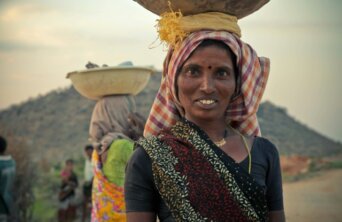- About
- Topics
- Story
- In-Depth
- Picks
- Opinion
- News
- Donate
- Signup for our newsletterOur Editors' Best Picks.Send
Read, Debate: Engage.
| topic: | Sustainable Agriculture |
|---|---|
| located: | India |
| editor: | Hanan Zaffar |
Last week, thousands of Indian farmers began a rallying march towards the capital to compel the government to address their grievances, only to be stopped by the police about 125 miles from the national capital, New Delhi.
Authorities in the Haryana state, which shares a border with New Delhi, deployed tear gas against the farmers to impede their march towards the capital and barricaded various entry points with barbed wire, spikes, and cement blocks.
Law enforcement agencies have prohibited large gatherings in Delhi and suspended internet services in several districts of Haryana. Several protesting farmers have been injured and detained by the police.
The protesting farmers, predominantly from Punjab and Haryana, famous as India's breadbasket regions, are demanding legal assurances of a minimum support price (MSP), which serves as a safety net for the agricultural community. Additionally, they demand waivers for farm loans, a reversal of policies they say are detrimental to farmers, compensation for protestors who lost lives during the 2020-2021 protests, and the withdrawal of court cases filed against protesters.
The MSP, representing the price at which the government procures crops from farmers, ensures a guaranteed income for their produce amidst market uncertainties. Their demand is for the MSP to be set at a minimum of 50 per cent higher than the production cost of any crop.
This recent protest takes place just two months before the upcoming general elections. Prime Minister Narendra Modi's Hindu right-wing Bharatiya Janata Party (BJP) is seeking a third consecutive term. A similar protest erupted in 2020 after the Modi government proposed contentious agricultural reforms.
Following a year-long protest resulting in the government rolling back the reforms and forming a committee to address farmers' concerns, the situation has stagnated for the past three years. Moreover, the absence of representatives from Punjab, Haryana, and Uttar Pradesh on the committee of all major grain producers has left the farmers dissatisfied.
India's farmer protests align with similar demonstrations by their European counterparts. However, apart from rising cultivation costs, the concerns raised by European and Indian farmers differ. While European farmers protest against the European Union's climate change mitigation efforts, among other issues, Indian farmers primarily focus on state-set guaranteed prices for their crops.
What makes the situation worse for the Indian farmers is their persistent challenges, such as mounting debt due to crop failures, leading to thousands of farmer suicides every year. Extreme weather events and diminishing water sources have also adversely affected agriculture output due to climate change.
Despite two rounds of talks between a government delegation and farm leaders, a resolution has yet to be reached. Farmers perceive these talks as stalling tactics and remain determined in their protest until the promises made in 2021 are fulfilled. Over 200 unions are participating in the march, with the farmers aiming to reach the capital after crossing Haryana.
The protesters have received some support from the Punjab and Haryana High Court, which said that as citizens of the country, the farmers have the "right to move freely." Opposition leader Rahul Gandhi has also accused the Modi government of having a "dictatorial attitude" towards the nation's food providers.
Image by Ron Hansen.

